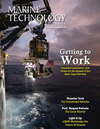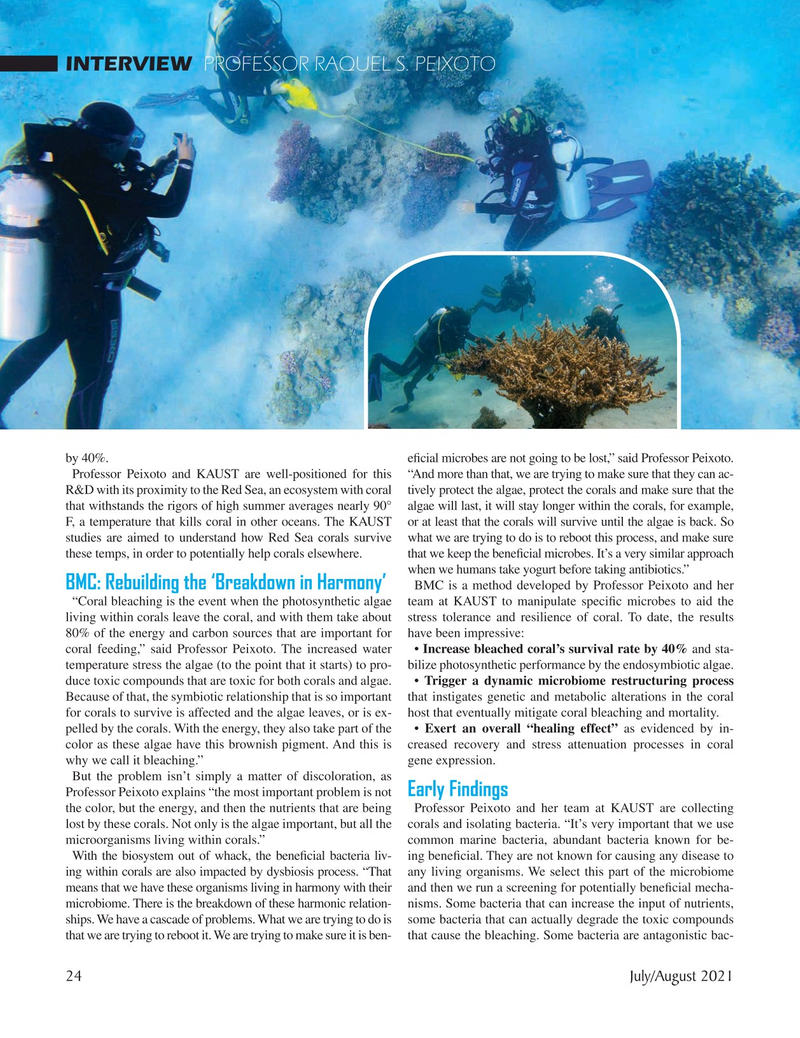
Page 24: of Marine Technology Magazine (July 2021)
Autonomous Vehicle Operations
Read this page in Pdf, Flash or Html5 edition of July 2021 Marine Technology Magazine
INTERVIEW PROFESSOR RAQUEL S. PEIXOTO by 40%. e? cial microbes are not going to be lost,” said Professor Peixoto.
Professor Peixoto and KAUST are well-positioned for this “And more than that, we are trying to make sure that they can ac-
R&D with its proximity to the Red Sea, an ecosystem with coral tively protect the algae, protect the corals and make sure that the that withstands the rigors of high summer averages nearly 90° algae will last, it will stay longer within the corals, for example,
F, a temperature that kills coral in other oceans. The KAUST or at least that the corals will survive until the algae is back. So studies are aimed to understand how Red Sea corals survive what we are trying to do is to reboot this process, and make sure these temps, in order to potentially help corals elsewhere. that we keep the bene? cial microbes. It’s a very similar approach when we humans take yogurt before taking antibiotics.”
BMC: Rebuilding the ‘Breakdown in Harmony’ BMC is a method developed by Professor Peixoto and her “Coral bleaching is the event when the photosynthetic algae team at KAUST to manipulate speci? c microbes to aid the living within corals leave the coral, and with them take about stress tolerance and resilience of coral. To date, the results 80% of the energy and carbon sources that are important for have been impressive: coral feeding,” said Professor Peixoto. The increased water • Increase bleached coral’s survival rate by 40% and sta- temperature stress the algae (to the point that it starts) to pro- bilize photosynthetic performance by the endosymbiotic algae.
duce toxic compounds that are toxic for both corals and algae. • Trigger a dynamic microbiome restructuring process
Because of that, the symbiotic relationship that is so important that instigates genetic and metabolic alterations in the coral for corals to survive is affected and the algae leaves, or is ex- host that eventually mitigate coral bleaching and mortality.
pelled by the corals. With the energy, they also take part of the • Exert an overall “healing effect” as evidenced by in- color as these algae have this brownish pigment. And this is creased recovery and stress attenuation processes in coral why we call it bleaching.” gene expression.
But the problem isn’t simply a matter of discoloration, as
Professor Peixoto explains “the most important problem is not Early Findings the color, but the energy, and then the nutrients that are being Professor Peixoto and her team at KAUST are collecting lost by these corals. Not only is the algae important, but all the corals and isolating bacteria. “It’s very important that we use microorganisms living within corals.” common marine bacteria, abundant bacteria known for be-
With the biosystem out of whack, the bene? cial bacteria liv- ing bene? cial. They are not known for causing any disease to ing within corals are also impacted by dysbiosis process. “That any living organisms. We select this part of the microbiome means that we have these organisms living in harmony with their and then we run a screening for potentially bene? cial mecha- microbiome. There is the breakdown of these harmonic relation- nisms. Some bacteria that can increase the input of nutrients, ships. We have a cascade of problems. What we are trying to do is some bacteria that can actually degrade the toxic compounds that we are trying to reboot it. We are trying to make sure it is ben- that cause the bleaching. Some bacteria are antagonistic bac- 24 July/August 2021
MTR #5 (18-33).indd 24 7/30/2021 11:21:36 AM

 23
23

 25
25
